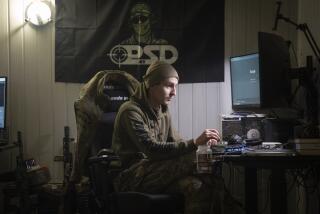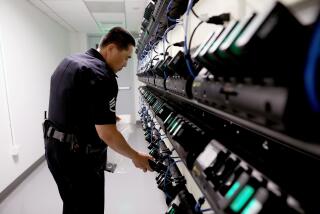Intelligence From GIs Outdoes Gadgetry in Taking the Pulse of Bosnia
- Share via
TUZLA, Bosnia-Herzegovina — The U.S. Army has deployed state-of-the-art technology here: Satellites can produce detailed images revealing troop and materiel sites. Vibration-sensing devices planted on the front line can detect big objects--like soldiers or tanks--passing by. Ground-surveillance radar can cut through persistent fog to trace military movements.
But so far, officials say, all these ultramodern spy gadgets have been outshone in gathering information for the Bosnian peacekeeping mission by something far more basic--the eyes and ears of thousands of U.S. soldiers patrolling the countryside and meeting with local commanders.
“Although we certainly have some sophisticated means of gathering information, the greatest source we have is soldiers on the ground,” said U.S. Army Maj. Kevin Doyle, a senior intelligence officer. “That sounds funny in this day and age, but it’s true. They get a human impression--one thing you can’t get through technical means.”
Because the chief goals of American forces in Bosnia-Herzegovina are to enforce the Dayton, Ohio, peace agreement and keep U.S. troops safe, information gathering--which usually plays a secondary, supporting role in a military operation--has become a central function.
Indeed, about 900 U.S. intelligence officers have been deployed here.
Despite this hefty presence of spy experts, regular Army officers and enlisted soldiers are being asked to shoulder a big intelligence role.
“We’re asking guys on the ground to do it, we’re asking the helicopters to do it, we’re asking guys driving trucks, we’re asking MPs,” Doyle said. “The unit as a whole is being asked to make a call on compliance with the [Dayton] treaty, so in this case, intelligence is the mission.”
Army experts already have seen how U.S. forces have executed their duties.
As the deadline approached recently for the former Bosnian adversaries to pull their forces from a “zone of separation,” as required in the Dayton accord, it was soldiers, for example, from the 3-325 Airborne Battalion Combat Team--not military intelligence or technology--who provided data that North Atlantic Treaty Organization commanders needed to determine that the sides were complying.
Tensions were high that day because Bosnian Serb commanders had signaled to U.S. soldiers who controlled the area that they did not intend to withdraw on time from their positions in the Majevica mountains. They said they would give up their posts only to Russian forces, who were not yet in place.
Then, the Serbs relented. U.S. Army Maj. Gordon Davis of Fort Myers, Fla., who was meeting with local Serbian commanders, got the news firsthand. He used his Humvee radio to send word to headquarters.
How, though, were American officials to check the Serbian compliance? After darkness fell, Army Lt. Paul Dill of Alexandria, Va., used a heat-sensing scope on his tank not far from Serbian lines to monitor the Serbs’ withdrawal from their entrenched positions.
“There are just a couple hot spots on the ridge line,” Dill said after peering through the scope. “We think it’s their fires just cooling down.
“We were just there in the trenches this morning,” he added, noting that it was “weird” to actually watch as the Serbs gave up their positions.
Besides this incident, field troops have gathered extensive--and vital--information: Troops patrolling the separation zone have scrutinized the former combatants to ensure that they were not carrying weapons in the area, as required under the Dayton accord; satellites, radar and other high-tech sensors, experts say, cannot provide data on matters so small-scale such as whether a soldier is lugging a gun.
Further, thick fog, heavy snow and other local conditions have blinded some of the biggest and best military spy equipment. Intelligence experts could not launch unmanned planes because of foul weather; radar devices have proven largely useless because of the mountainous terrain; the super-satellites still cannot see inside buildings to monitor troops or equipment there.
But another piece of large hardware--the helicopter--has been especially helpful in ensuring the sides comply with the peace accord. “We’ve used the heck out of the helicopters,” Doyle said. “We’re flying the wings off them. They’re very versatile. They can fly low. They take pictures. They have a pilot that you can talk to, so if you want him to fly right back to look again, you can ask him to do that. That’s tough to do with a satellite.”
Some hidden heavy weapons left in the separation zone after the deadline were missed in satellite photographs. They were, however, detected by soldiers and copter crews; Doyle tells, for example, how troops on the ground found a tank that was buried almost up to its turret and had been there for so long that small trees were growing out of it.
As the Serbs, Croats and Muslim-led government forces race to meet a deadline two months from now to consolidate their military equipment, U.S. forces have been trying to figure out where all the materiel is now. “The only way we can make a call on whether they’ve consolidated all their equipment is to get a handle on where their equipment is now,” Doyle said.
By getting a handle on how other humans are reacting to them, ground soldiers also are playing a crucial role, experts say, in their own protection. They can sense hostility toward them in ways that no spy or technology can.
In addition, because the former combatants have mostly met their treaty responsibilities and kept the peace, the U.S. and other foreign soldiers here have enjoyed an unusual freedom to snoop. “We have great access,” Doyle said. “Our helicopters don’t have a large air-defense threat. The soldiers can walk up and ask questions of the Serbs or of the Bosnian Croats or Bosnian Muslims, and they can get answers.”
Meanwhile, the high-tech U.S. spy machines and intelligence professionals are still hard at work. Base camps scattered around the American sector of Bosnia are equipped with tactical satellites so that they can communicate with headquarters, even in emergencies when radio contact might otherwise be cut. They have computers that can go online with the mighty Warlord computer at the U.S. headquarters in Tuzla to get up-to-date information on everything from mine sites to weather forecasts.
The Warlord computer, combined with intelligence officers’ expertise, is also tackling the herculean task of compiling and analyzing field reports. The computer receives data directly from satellites and other devices. Field reports are entered by headquarters staff, then data is analyzed and condensed into intelligence summaries.
Almost 99.9% of the reports are stamped with a new classification: “Releasable to IFOR,” the acronym for the international peace force in Bosnia. The Implementation Force, experts note, shares the data with all troops in the NATO-led alliance, including the onetime U.S. Cold War foes, the Russians.
More to Read
Sign up for Essential California
The most important California stories and recommendations in your inbox every morning.
You may occasionally receive promotional content from the Los Angeles Times.












